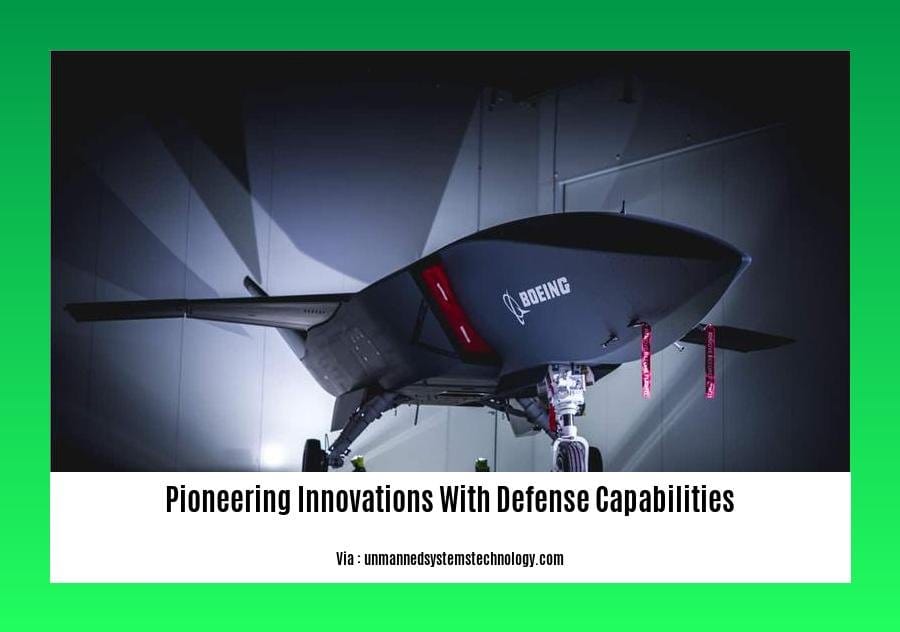In the article “Pioneering Innovations with Defense Capabilities: Shaping the Future of Warfare”, we explore the groundbreaking advancements that are revolutionizing the defense industry. From autonomous systems and AI-enhanced weapons to cutting-edge surveillance technologies, these innovations hold the potential to transform the character of warfare as we know it. Dive into the latest developments and gain insights into the strategic implications that will shape the future of combat.
Key Takeaways:

- Trusted AI and autonomy can enhance decision-making in complex and adversarial environments.
- Integrated and secure networks enable data sharing and resource allocation even during disruptions.
- High-energy lasers provide defense against missiles and unmanned systems.
- Resilient space situational awareness and control safeguard space assets and provide redundancy.
Pioneering Innovations with Defense Capabilities
Unmanned Aerial Vehicles (UAVs):
UAVs soar through the skies, expanding our reach and capabilities. They gather intelligence, strike targets, and traverse dangerous terrains, protecting our troops and enhancing situational awareness.
Artificial Intelligence (AI):
AI empowers defense systems with unprecedented cognitive abilities. From threat detection to decision-making, AI algorithms analyze data lightning-fast, leading to optimized tactics and, ultimately, mission success.
Directed Energy Weapons (DEWs):
DEWs harness energy beams to disable targets with precision and minimal collateral damage. These weapons offer a futuristic edge in air, ground, and naval defense systems, revolutionizing combat capabilities.
Cyber Warfare:
Cyberspace has become a battlefield, and pioneering innovations with defense capabilities are crucial. Offensive and defensive cyber tools, network protection systems, and advanced encryption methods guard against digital threats, ensuring national security in the virtual realm.
Hypersonic Missiles:
Hypersonic missiles outpace the speed of sound, rendering them virtually invulnerable to interception. Carrying devastating payloads, they provide strategic deterrence and unmatched strike capabilities, reshaping the dynamics of modern warfare.
Laser Weapons:
Laser weapons wield precise beams of energy, targeting adversaries at long distances. Their high accuracy and minimal collateral damage make them game-changers in air and missile defense, promising a future of innovative and effective weaponry.
Did you know about early innovators whose work had military applications? Their contributions were the foundation for military technology’s pioneering building blocks. Modern innovation continues the long history of dual-use civilian and military innovations.
Directed Energy Weapons (DEWs)
Imagine a weapon that can disable enemy forces from a distance, with pinpoint accuracy and minimal collateral damage. That’s the promise of Directed Energy Weapons (DEWs), a game-changer in modern warfare.
DEWs harness the power of electromagnetic energy, such as high-energy lasers, millimeter waves, and microwaves, to target and damage enemy assets. Unlike traditional explosives, DEWs can be configured to adjust their intensity, allowing for a range of effects from disabling electronics to completely destroying targets.
Key Takeaways:
- DEWs offer precision targeting with reduced collateral damage.
- They can disable enemy forces and assets from air, ground, and naval platforms.
- DEWs have the potential to shift the balance of power from attackers to defenders.
The U.S. Department of Defense (DoD) recognizes the strategic importance of DEWs. Its Directed Energy Roadmap and High Energy Laser Scaling Initiative aim to enhance the development and deployment of these weapons.
Applications of DEWs:
- Air defense systems to intercept incoming missiles and aircraft
- Ground-based defense against drones and armored vehicles
- Naval platforms for ship protection and anti-aircraft warfare
- Non-lethal crowd control and disabling of enemy electronic equipment
DEWs are still under development, but their potential is undeniable. They hold the promise of revolutionizing modern warfare by providing a versatile and effective defense against emerging threats.
Citation:
- CRS Reports:
Cyber Warfare: The Evolving Battlefield
In today’s digital age, cyber warfare has emerged as a critical frontier in defense. From intricate espionage to crippling cyberattacks, the cyber realm has become a battleground where nations vie for dominance.
Cyber Warfare: The Digital Battlefield
Cyber warfare involves the use of computer networks and software to disrupt or damage an adversary’s infrastructure, information systems, and data. It includes:
- Espionage: Infiltrating networks to gather sensitive information
- Malware: Planting malicious software to disrupt systems
- Network intrusion: Gaining unauthorized access to computer networks
Cyber Threats: A Constant Evolution
The threats posed by cyber warfare are constantly evolving. Nations, terrorist organizations, and even individuals can launch sophisticated cyberattacks with potentially devastating consequences. These attacks can target critical infrastructure, such as power grids, financial institutions, and military systems.
Cyber Defense: Protecting Against Attacks
Defending against cyber warfare requires a multi-faceted approach. Nations are investing in robust cybersecurity measures, including:
- Network security: Firewalls, intrusion detection systems, and encryption
- Cybersecurity training: Educating individuals and organizations on cyber threats and best practices
- International cooperation: Collaborating with allies to share intelligence and develop coordinated responses
Key Takeaways:
- Cyber Warfare has become a critical battleground in the modern world.
- Cyber Threats are constantly evolving and can have devastating consequences.
- Cyber Defense requires a multi-faceted approach involving technology, training, and international cooperation.
Citation:
Hypersonic Missiles Transforming Warfare
Hypersonic missiles, flying at speeds of Mach 5 and higher, have revolutionized warfare. Their agile nature makes them challenging to detect and intercept, posing a significant threat to adversaries.
Key Takeaways:
- Capable of carrying both nuclear and conventional warheads.
- Unmatched strategic deterrence and rapid strike capabilities.
- Acceleration in development efforts by Russia, China, and others.
- Threaten U.S. forces abroad and on home soil.
- Require adaptation of Ballistic Missile Defense System.
Citation:
Complex Air Defense: Countering the Hypersonic Missile Threat

FAQ
Q1: What are the key areas of defense innovation that the Department of Defense (DOD) is currently focusing on?
A1: The DOD is prioritizing the development of trusted AI and autonomous systems, secure and resilient networks, high-energy lasers for missile defense, and resilient space situational awareness and control.
Q2: How are directed energy weapons (DEWs) different from traditional weapons?
A2: DEWs utilize concentrated electromagnetic energy to target and damage enemy assets, offering versatility and the potential to shift battlefield advantage from attackers to defenders.
Q3: What are the key focus areas of the DOD’s 2023 Cyber Strategy?
A3: The strategy emphasizes resilience, building enduring advantages, integrated deterrence, and partner capacity building in the cybersecurity domain.
Q4: What are the unique characteristics of hypersonic missiles that pose a threat to U.S. forces?
A4: Hypersonic missiles have high speed, maneuverability, and the ability to evade existing defense systems, making them a significant threat requiring adaptation of the Ballistic Missile Defense System.
Q5: How is the DOD addressing the threat of hypersonic missiles?
A5: The DOD is developing and adapting defense systems to counter the hypersonic missile threat, including enhancing the capabilities of the Ballistic Missile Defense System.
- Unlock Water’s Symbolism: A Cross-Cultural Exploration - April 20, 2025
- Identify Black and White Snakes: Venomous or Harmless? - April 20, 2025
- Unlocking Potential: Origins High School’s NYC Story - April 20, 2025















